![]()
![]()
![]()
Use LEFT and RIGHT arrow keys to navigate between flashcards;
Use UP and DOWN arrow keys to flip the card;
H to show hint;
A reads text to speech;
155 Cards in this Set
- Front
- Back
- 3rd side (hint)
|
LU-1
Central Storage |
Medial to the greater tubercle of the humerus (when standing) in the superficial pectoral muscle at the level of the 1st intercostal space
|
Front-Mu (Alarm) point for Lung
Immune Regulation, Lung Heat, cough, dyspnea |
|
|
LU-5
Cubit Marsh |
Medial side of the cubital crease, just lateral to the tendon of the biceps brachii muscle with the elbow flexed. * lift leg at 90 degrees, slide finger up the cephalic vein to cubital crease, find tendon medially and stay lateral from it |
He-sea point (water)
Water point (sedate) for Lung, Lung Heat, fever, cough, asthma |
|
|
LU-7 |
Just proximal to the styloid process of the radius, 1.5 cun above the radiocarpal joint.
|
Luo-connecting point to LU (LI-6)
Confluent point of CV Channel Master point for head and neck |
|
|
LU-9
Great Abyss |
On the medial aspect of radio carpal joint, just cranial to the radial artery, at the level of HT-7.
|
Shu-stream (Earth) point, Mother point for Deficiency. Yuan (Source) point, influential point of blood vessels. Lung Deficiency, cough, asthma, dyspnea.
|
|
|
HT-1
Highest Spring |
In the center of the axillary space (between trunk and the forelimb) into the superficial pectoral muscle. * go straight into axillae as far as you can |
Shen disturbance, increased thirst, Yin Deficiency, chest pain, shoulder pain
|
|
|
HT-3
Minor Sea |
On the medial side of the elbow just cranial to the medial epicondyle. * hug the medial epicondyle, PC-3 is more cranial by biceps tendon |
He-sea point (Water). Elbow pain, chest pain, congestive heart failure
|
|
|
HT-7
Spirit Gate |
On the transverse crease of the carpal joint in the large depression lateral to the tendon of the flexor carpi ulnaris muscle and caudal to the tendon of the ulnaris laterals muscle. * deep hole above accessory pad |
Shu-stream point (Earth), Yuan (Source) point, Son point for Excess. Shen disturbance, anxiety, insomnia, chest pain, poor memory, restlessness, epilepsy
|
|
|
HT-8 Lesser Mansion |
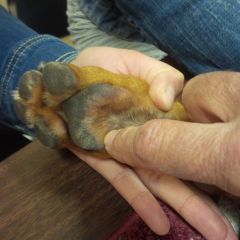
On the palmar surface of the paw between 4th-5th metacarpal bones, proximal to the metacarpophalangeal junction, just proximal to the pad base * just above the large pad, lateral side (not under pad) |
|
|
|
HT-9 Minor Channel |
Medial aspect of the nail bed of the 5th digit of the front foot.
|
|
|
|
PC-3 Elbow March |
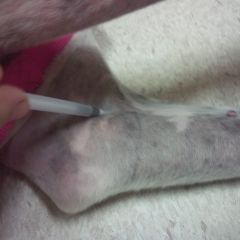
On the medial side of cubital crease, just caudal to the biceps tendon. * HT-3 is hugging the medial condyle, PC-3 is more cranial, then you feel the biceps tendon, then LU-5 |
|
|
|
PC-6
Inner Pass |
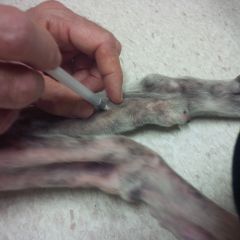
3 cun proximal to the transverse crease of the carpus in the groove between the flexor carpi radialis and the superficial digital flexor muscles in the interoseous space. * on opposite side is TH-5, find that first * radius = 12cun, 1/2 = 6 cun, 1/4 = 3cun * where muscle becomes tendon |
Luo-connecting point, Master point of chest/cranial abdomen, Confluent point to Yin-Wei. Vomiting, anxiety, insomnia, headache, chest pain, palpitation, paralysis of forelimbs, epilepsy
|
|
|
PC-7 Great Mound |
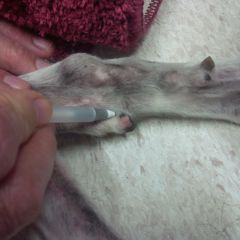
On the medial side of the thoracic limb, just proximal to the radiocarpal bone and caudal to the tendon of the flexor carpi radialis muscle under the proximal and medial aspect of the accessory carpal pad * under proximal and medial aspect of accessory pad |
|
|
|
PC-8 Palace of Toil |
Underneath the large central pad between the 3rd-4th metacarpal bones.
|
|
|
|
PC-9 Central Hub |
Medial aspect of the 4th digit at the nail bed.
|
|
|
|
LI-4
Union Valley |
Between 2-3 metacarpal bones, at the midpoint of the 3rd metacarpal bone on the medial side. For cats: the alternative location: the midpoint of the 2nd metacarpal bone on the medial side. * slide nail up as far as you can go, btw Mc 2-3 |
Yuan (Source) point, Master point for face and mouth. Nasal discharge/congestion, facial paralysis, dental pain
|
|
|
LI-10
Front 3 Mile |
2 cun distal to LI-11 (1/6 of the distance between the elbow and carpus) between the extensor carpi radials and the common digital extensor muscles. * find LI-11 first, slight lateral to cephalic vein * elbow to carpus = 12cun, 1/2 = 6 cun, 1/4 = 3cun |
Immune regulation, general tonic, skin itching, diarrhea, Wind-Heat, elbow pain, front limb and pelvic limb weakness
|
|
|
LI-11
Pool on the Bend |
Lateral end of the cubital crease, 1/2 distance between the biceps tendon and the lateral epicondyle of the humerus when the elbow is flexed. * you can see the large depression |
He-sea point (Earth), Mother point for Deficiency. Wind-Heat, diarrhea, constipation, elbow pain
|
|
|
LI-15 Shoulder bone |
Cranial and distal to the acromion on the cranial margin of the acromial head of the deltoideus muscle. * top part of acromium * Th-14 is below the acromium |
|
|
|
LI-20
Welcome Aroma |
In the nasal labial groove, lateral of the nose, at the level of the widest part of the nostril and approximately 0.1 cun caudal to the haired/non-haired border.
|
Use for sinusitis or nasal discharge
|
|
|
SI-3
Back Ravine |
Just proximal to the metacarpophalangeal joint on the caudolateral side of the 5th metacarpal bone.
|
Shu-stream point (Wood), Mother point for Deficiency, Confluent point of GV Channel, Cervical stiffness, back pain, red eyes
|
|
|
SI-4 Wrist Bone |
On the lateral side of the thoracic limb, distal to the carpal joint, caudolateral to the base of the 5th metacarpal bone.
|
|
|
|
SI-8 Small Sea |
Medial elbow between the medial humeral epicondyle and the olecranon. (This point is at the ulnar nerve (“funny bone”).
|
|
|
|
SI-9
Shoulder Hollow |
Caudal to the humerus, in a large depression along the caudal border of the deltoid muscle at its juncture with the triceps muscle. (Between the long and lateral heads of the triceps muscle, at the level of the shoulder joint). * slide from above in depression, in the middle of lateral upper leg |
Ear problems, shoulder pain, front limb lameness or paralysis, Master point for fore limbs
|
|
|
SI-16 Celestial Window |
In brachiocephalicus muscle, at the level of the C2-3 intervertebral space, 3 cun ventrolateral to the dorsal midline * use the width of the last rib = 1cun * wrap hand around the neck, index finds atlas (C1), slide down to find C2-C3, then slide up on the neck to be 3cun away from midline * it is dorsal from Jing-Jia-Ji |
|
|
|
SI-19
Hearing Place |
Rostal to the tragus (ventral to TH-21), at the caudal border of the mandible and slightly dorsal to the condyloid process. * find tragus, go below it off cartilage, move ear around and your finger should not move * TH-21 is above, GB-2 is behind |
Otitis, deafness, headshaking, dental pain, epilepsy
|
|
|
TH-3 Central Island |
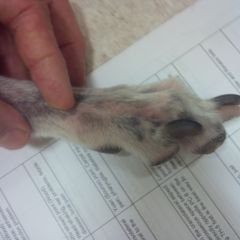
Dorsum of the forefoot between 4th-5th metacarpal bones, in the depression just proximal to the metacarpophalangeal joint * slide nail up between 4-5 Mc, not too far up |
|
|
|
TH-4 Divergent Yang |

In the large lateral depression on the dorsolateral aspect of the radiocarpal joint, just lateral to the common digital extensor tendon * go up btw metacarpals 4-5, flex the carpus, go over the joint and find depression at jt |
|
|
|
TH-5
Outer Pass |
3 cun above the carpus on the craniolateral aspect of the forelimb in the interosseous space between the radius and ulna. * directly opposite is PC-6 on the medial aspect * finding TH-5 first is the best way to find PC-6 |
Luo-connecting point, Confluent point to Yang-wei. Paralysis fo forelimbs, headache, febrile disease, red eyes, ear problems, neck pain, Wei Qi Deficiency
|
|
|
TH-10 Celestial Well |
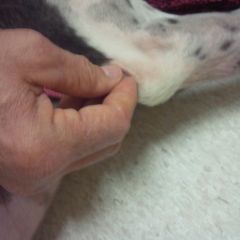
In a depression on the triceps tendon, just proximal to the olecranon.
|
|
|
|
TH-14 Shoulder Seam |
Caudal and distal to the acromion on the caudal margin of the acromial head of the deltoideus muscle. * LI-15 is cranial (top) of acromial head |
|
|
|
TH-17 Wind Screen |
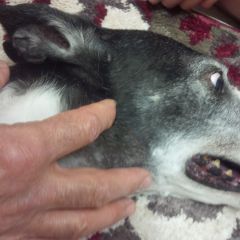
Ventral to the ear in the depression between the mandible and the mastoid process. * go from ear canal towards angle of mandible, the point is where the horizontal ear canal turns deep into vertical canal |
|
|
|
TH-21 Ear Gate |

Rostral to the pretragic incisure directly dorsal to SI-19 at the caudal border of the mandible and dorsal to the condyloid process with the mouth open. * right near cartilage * you have TH-21, SI-19 and GB-2 in that area |
|
|
|
TH-23 Silk Bamboo Hole |
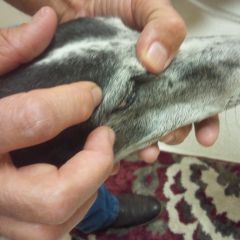
In the depression on the rim of the orbit at the end of the eyebrow, if it were extended to the lateral canthus. * go along the upper orbit on eyebrow line until you find the depression * GB-1 is a little further by lateral canthus |
|
|
|
SP-3
Greater White |
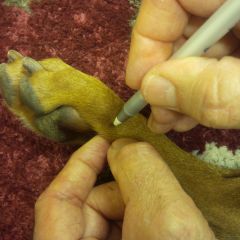
On the medial side of the pelvic limb just proximal to the metatarsophalangeal joint on the plantomedial side of the 2nd metatarsal bone. * between bone and tendon |
Shu-steam point (Earth), Yuan (Source) point, Horary point.
Abdominal pain, diarrhea, constipation, obesity, stifle and thigh pain |
|
|
SP-4 Yellow Emperor |
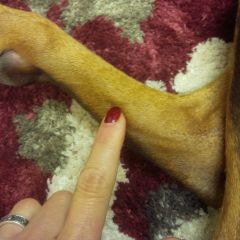
On the plantomedial side of the pelvic limb in thedepression distal to the base (proximal end) of the2nd metatarsal bone
|
|
|
|
SP-6
3 Yin Crossing |
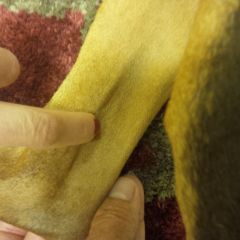
3 cun proximal to the tip of the medial malleolus in a small depression on the caudal border of the tibia * GB-39 if on the lateral side * slide finger up on back of tibia to feel flat surface |
Master point for the caudal abdomen and urogenital system.
Yin/Blood Deficiency, Damp, watery diarrhea, uterine problems |
|
|
SP-8 Earth's Crux |
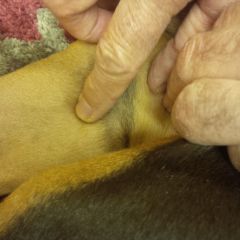
Medial side of the pelvic limb, 3 cun distal to SP-9, on the caudal border of the tibia, cranial to the deep digital flexor muscle * find SP-8 first, the slide finger down along the back of tibia, 3cun or until you feel a small tendon (in most cases) * photo shows SP-8 and SP-9 |
|
|
|
SP-9
Yin Mound Spring |
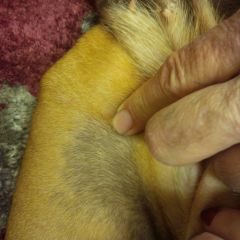
On the lower border of the medial condyle of the tibia, in the depression between the caudal border of the tibia and the gastrocnemius muscle. * following the back of the tibia up until it bends caudally just below the medial tibial condyle |
He-sea point (water)
Yin Deficiency, Damp, watery diarrhea, skin itching, Wei syndrome |
|
|
SP-10
Sea of Blood |
Stifle flexed, 2 cun proximal and medial to the patella (on a diagonal from the patella) in the depression just cranial to the second belly of the sartorial muscle. * find ST 35a/b, above is patella, go one patella length up and one patella caudal on medial leg |
Blood Deficiency, Blood Heat, Blood Stagnation, skin itching, pelvic limb paresis or paralysis
|
|
|
SP-21 Great Embracement |
On the lateral aspect of the thorax at the 7th intercostal space at the same level as the point of the shoulder * count ribs from 13th backwards * spleen-seven space-shoulder (all start with s) |
|
|
|
KID-1
Gushing Spring |
Rear leg, under central pad, between 3rd-4th metatarsal bones * PC-8 is the same for front foot |
Jing-well point (Wood), Son point for Excess. Rear weakness, coma, sore throat, urinary dribbling, aphonia (loss of voice)
|
|
|
KID-3
Great Ravine |
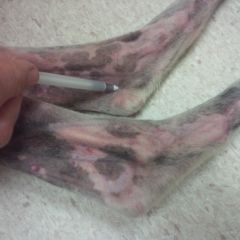
In thin fleshy tissue between the medial malleolus and calcaneus level with the tip of the medial malleolus. * draw line btw tip of medial malleolus and calcaneus, point is in middle of membrane * BL-60 is on lateral side and a little higher. |
Yuan (source) point for Kidney. Shu-stream point (Earth). Reanl failure, diabetes, dyspnea, deafness, ear problems, back pain, impotence, dysuria
|
|
|
KID-6 Shining Sea |
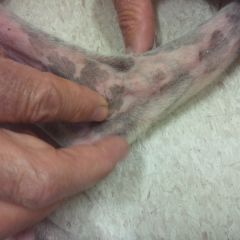
Hock flexed, in a depression immediately distal and right on the back of the medial malleolus. * it is lower than KID-3 |
|
|
|
KID-7
Recover Flow |
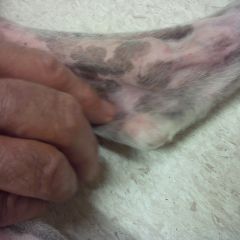
2 cun proximal to the tip of the medial malleolus, on the cranial border of the Achilles tendon. * SP-6 is 3 cun from malleolus on back of tibia * malleolus to tibial plateau = 13cun on medial side |
Jing-river point (Metal), Mother point for Deficiency. Anhidrosis, diarrhea, edema, abdominal fullness, paralysis of pelvic limbs
|
|
|
KID-10
Yin Valley |
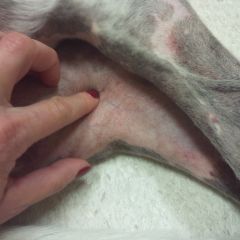
On the medial side of the popliteal fossa at the level of BL-40, in between semimembranous and semitendinous muscles. * pinch muscle at level of popliteal fossa * medial KID-10, then BL-40, then BL-39 (lateral) |
He-sea point (Water). Impotence, hernia, dysuria, stifle pain
|
|
|
LIV-2 Moving Between |
Lateral aspect of the 2nd digit, distal to the metatarsophalangeal joint in the webbing. * high in the web, close to jt btw digits 2-3 * similar to ST-44 |
|
|
|
LIV-3
Supreme Surge |
Between the 2nd and 3rd metatarsal bones, proximal to the metatarsophalangeal joint. * go with the nail up btw Mt 2-3, not too high |
Shu-stream point (Earth), Yuan primary (Source) point. Liver Qi Stagnation, abnormal cycle, paralysis of pelvic limbs
|
|
|
LIV-8
Spring at the bend |
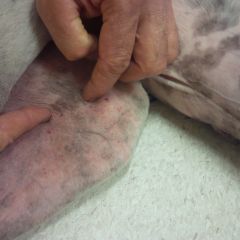
On the medial side of the knee at the medial aspect of the popliteal crease caudal to the medial femoral condyle * cranial to KID-10, caudal to medial condyle. |
He-sea point (Water), male and female reproductive disorders, uterine prolapse, genital prolapse, genital pruritis, urinary incontinence, stifle pain
|
|
|
LIV-13 Gate of Symbol |
On the lateral side of the body, just below the free end of the 12th rib.
|
|
|
|
LIV-14 Cycle Gate |
In a depression at the costochondral junction ofthe 6th intercostal space (btw ribs 6-7)
|
|
|
|
ST-1
Receiving Tears |
Directly below the center of the pupil, just inside the infraorbital ridge.
|
Conjunctivitis, uveitis, Liver Heat
|
|
|
ST-2 Four Whites |
Depression in the infraorbital foramen.
|
|
|
|
ST-4 Earth Granary |
At the lateral commissure of the mouth 0.1 cun caudal to the mucocutaneous border.
|
|
|
|
ST-6 Jawbone |
In the depression in the middle of the massetermuscle just rostral to the angle of the mandible. * slide the finger from corner of the mouth, up over the masseter m. to find central depression |
|
|
|
ST-7 Xia-guan |
Caudal to the masseter muscle and cranial to the temporomandibular joint. * go along the zygomatic arch to the end of masseter m., the point is below the arch, GB-3 (Shang-guan) is above it |
Dental pain, mandible pain, facial paralysis, headache, head shaking
|
|
|
ST-25
Celestial Center |
2 cun lateral to the center of the umbilicus, in the center of rectus abdomens muscle.
|
Front Mu (Alarm) point for LI.
Constipation, diarrhea, abdominal pain, vomiting |
|
|
ST-35a
Calf's Nose |
Distal to the patella, lateral to the patella ligament. Also referred to as "the lateral eye of the knee"
|
Stifle problems, rear limb weakness
|
|
|
ST-35b
Knee Curve |
Distal to the patella , medial to the patellar ligament is a point also referred to as "the medial eye of the knee"
|
Stifle problems, rear limb weakness
|
|
|
ST-36
Rear 3 Miles |
3 cun distal to ST-35, 0.5 cun lateral to the cranial crest of the tibia; in the belly of the cranial tibialis muscle (long linear point).
|
He-sea (Earth) point, Master point for gastrointestinal tract and abdomen. Nausea, vomiting, gastric pain, gastric ulcer, food stasis, general tonic
|
|
|
ST-37
Upper Great Hollow |
3 cun distal to ST-36, 0.5 cun lateral to the cranial aspect of the limb, in cranial tibialis muscle. * go down with very light pressure |
Lower He-sea point for LI Channel, diarrhea, intestinal ulcers, constipation
|
|
|
ST-39
Lower Great Hollow |
3 cun distal to ST-37, 0.5 cun lateral to the cranial aspect of the limb, in cranial tibialis muscle (1 cun distal to the midpoint of the tibia). * find ST-36, ST-37. ST-39 is above the point of the lateral saphenous vein * at the point where muscle goes to tendon |
Lower He-sea point for SI Channel, diarrhea, abdominal pain, dysentery, hemiplesia, impaction
|
|
|
ST-40
Bountiful Bulge |
1/2 distance between the lateral malleolus and the tibial plateau (8 cun), 2 cun lateral to the cranial aspect of the limb in the groove between the cranial tibialis and long digital extensor muscles. This point is proximal to ST-39 (higher) * don't do too lateral, you should still have muscle belly further lateral |
Luo-connecting point to Spleen, Influentioal point for Phlegm. Obesity, lipoma, Damp-Heat, skin itching
|
|
|
ST-41
Ravine Divide |

On the dorsum of the rear foot at the level of the hock in the depression directly on the midline. The point lies between the ligaments of the long digital extensor and the cranial tibial muscles. * lift and bend the leg a little, medial to mid tendon (in the split of the tendon) |
Jing-river point (Fire). Wei syndrome, paresis/paralysis of pelvic limb, Spleen Deficiency
|
|
|
ST-42
Surging Yang |
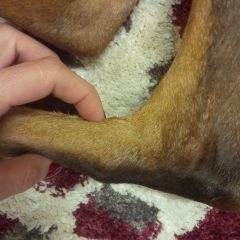
On the dorsal aspect of the metatarsus at the junction of the 3-4 metatarsal bones of the pelvic limb. * find the top of metatarsus on lateral side, then go medial and a little lower btw Mt3-4 |
Yuan (Source) point. Facial paralysis, facial swelling, dental problems, epilepsy, Wei syndrome, gastric pain
|
|
|
ST-44
Inner Court |
Web margin between the 3-4 digits, in the depression just distal and lateral to the 3rd metatarsophalangeal joint. * high btw toes |
Ying-spring point (water).
Stomach Heat, gastric ulcers |
|
|
ST-45
Severe Mouth |
Lateral side of the 3rd digit nail base.
|
Jing-well (Metal) point
Son point for Excess Diagnostic and treatment point for appetite |
|
|
BL-1 Bright Eye |
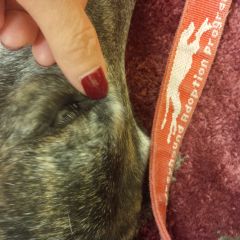
0.1 cun dorsal to the medial canthus of the eye.
|
|
|
|
BL-2 Bamboo Gathering |
In the supraorbital ridge ventral to the medial end of the eyebrow. * follow the bone from medial canthus to small divot by eyebrow |
|
|
|
BL-10 Celetial Pillar |
1.5 cun from the dorsal midline of the neck at thelevel of the junction of C1 and C2 (on a line from the caudal edges of the wings of the atlas).
|
|
|
|
BL-11
Big Shuttle |
1.5 cun lateral to the caudal border of the dorsal spinous process of T1. * find GV-14 (3-finger technique) at C7-T1, go 1.5cun lateral to caudal T1 |
Influential point for Bone. Cough, fever, cervical stiffness, shoulder apin, degenerative joint disease, Intervertebral disk disease, back pain
|
|
|
BL-12 Wind Gate |
1.5 cun lateral to the caudal border of the dorsal spinous process of T2
|
|
|
|
BL-13 Lung's Hollow |
1.5 cun lateral to the caudal border of the dorsal spinous process of T3
|
|
|
|
BL-14 Pericardium Hollow |
1.5 cun lateral to the caudal border of the dorsal spinous process of T4
|
|
|
|
BL-15 Heart;s Hollow |
1.5 cun lateral to the caudal border of the dorsal spinous process of T5
|
|
|
|
BL-16 Governing Hollow |
1.5 cun lateral to the caudal border of the dorsal spinous process of T6
|
|
|
|
BL-17 Diaphragm's Hollow |
1.5 cun lateral to the caudal border of the dorsal spinous process of T7
|
|
|
|
BL-18
Liver's Hollow |
1.5 cun lateral tot he caudal border of the spinous process of T10 * something happens when you turn 18 :) (skip T8-9) |
Back-shu (Association) point for Liver. Jaundice, hepatic disease, eye problems, hypertension, back pain, epilepsy, irritability
|
|
|
BL-19
Gall Bladder Hollow |
1.5 cun lateral to the caudal border of the spinous process of T11
|
Back-shu (Association) point for Gall Bladder. Jaundice, hepatic diseases, lower-tidal fever, Liver Qi Stagnation
|
|
|
BL-20
Spleen's Hollow |
1.5 cun lateral to the caudal border of the spinous process of T12
|
Back-shu (Association) point for Spleen. Spleen Deficiency, Damp, abdominal fullness, vomiting, watery or bloody diarrhea, edema, jaundice, back pain.
|
|
|
BL-21
Stomach's Hollow |
1.5 cun lateral to the caudal border of the spinous process of T13 * feel the last rib |
Back-shu (Association) point for Stomach. Abdominal pain, constipation, vomiting, gastric ulcer, diarrhea, abdominal fullness
|
|
|
BL-22 Triple Heater Shu |
1.5 cun lateral to the caudal border of the dorsal spinous process of L1
|
|
|
|
BL-23
Kidney's Hollow |
1.5 cun lateral to the caudal border of the spinous process of L2 * draw line from last rib up to spine, to land at L2-L3 |
Back-shu (Association) point for Kidney. Kidney Yin/Qi Deficiency, urinary incontinence, impotence, deafness, sore and weak back
|
|
|
BL-24 Qi Sea Hollow |
1.5 cun lateral to the caudal border of the dorsal spinous process of L4 * skip L3 |
|
|
|
BL-25
Large Intestine Hollow |
1.5 cun lateral to the caudal border of the spinous process of L5
|
Back-shu (Association) point or Large Intestine. Abdominal pain, diarrhea, constipation, back pain
|
|
|
BL-26 Source Hollow |
1.5 cun lateral to the caudal border of the dorsal spinous process of L6
|
|
|
|
BL-28
Bladder Hollow |
Between S1-S2, 1.5 fun lateral to the dorsal midline. Between the sacrum and the medial border of the wings of the ilium. * find Bai-hui (3-finger technique) at L7-S1 first. |
Back shu (Association) point for Bladder. Dysuria, urinary incontinence, diarrhea, constipation, lumbosacral pain
|
|
|
BL-35 Meeting of Yang |
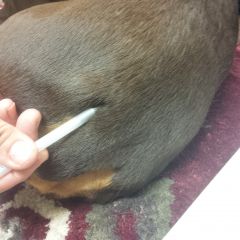
In the crease just lateral to the tail base, 1.5 cun lateral to the dorsal midline
|
|
|
|
BL-36 Support |
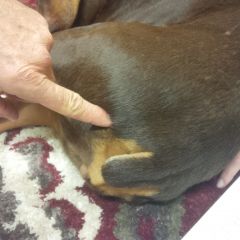
Ventral to the lateral border of the tuber ischia in the biceps groove (between biceps femoris and semitendinosus muscles) * sometimes located in or near a swirl of hair * slide fingers up caudolateral along biceps femoris to find tuber ischia, the go below it |
|
|
|
BL-39
Yang in the bend |
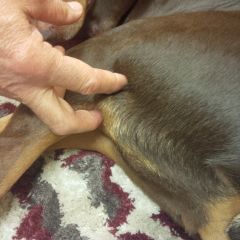
On the lateral end of the popliteal crease on the medial border of the biceps femurs tendon. Just lateral to BL-40. * pinch BL-40 lateral * on the medial side you have KID-10 |
Lower He-sea for Triple Heater.
Urinary dribbling, back pain, muscle spasms of rear limbs |
|
|
BL-40
Bend Middle |
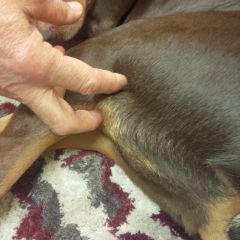
In the center of the popliteal crease. The point is found by directing the needle cranially towards the patella.
|
He-sea point (Earth). Master point for caudal back/hips. Dysuria, urinary incontinence, hip /back problems, autoimmune disease, vomiting, diarrhea
|
|
|
BL-52 Will Chamber |
3 cun lateral to the caudal border of the dorsal spinous process of L2 at the lateral border of longissimus muscle, 1.5 cun lateral to BL-23
|
|
|
|
BL-54
Sequential Limit |
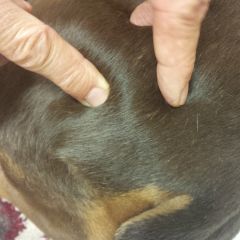
In a depression just dorsal to the greater trochanter of the femur. * one of the "three bowling-ball points" around the hip joint (GB-29, GB-30 and Bl-54 above) * find GB-30 first (halfway btw tuber ischia and cranial femur), BL-54 is above top of femur * photo shows BL-54 and GB-30 |
Mater point for the pelvic limbs. Paresis/paralysis of pelvic limbs, hip problems, perianal problems, lumber pain
|
|
|
BL-60
Mountains |
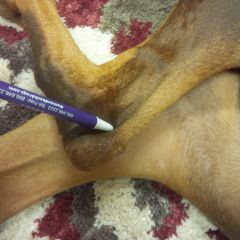
In the thin fleshy tissue between the lateral malleolus and the calcaneous, level with the tip of the lateral malleolus. * The point is opposite but slightly proximal to KID-3 * stick needle downwards from lateral through to medial to get both points at once |
Jing-river point (Fire). Nose-bleeding, difficult labor, back pain, hock pain, headache, cervical stiffness, hypertension, epilepsy
|
|
|
BL-62 Extending Vessel |
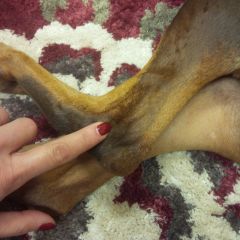
With the hock flexed, the point is located in a depression directly plantodistal to the lateral malleolus * KID-6 is on the other side |
|
|
|
BL-64 Capital Bone |

On the lateral aspect of the pelvic limb, distal to the base (proximal end) of the 5th metatarsal bone * similar to SP-4 on the 2nd metatarsal bone |
|
|
|
BL-67 Terminal Yin |
On the lateral aspect of the nail bed on the 5th digit of the rear foot
|
|
|
|
GB-1 Pupil Bone-Hole |
0.2 cun lateral to the lateral canthus in the depression over the orbital ligament
|
|
|
|
GB-3 Shan-guan |
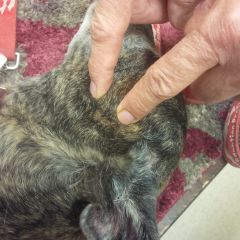
In the depression (more prominent with the mouth open) at the caudal end ofthe temporomandibular joint, caudal to the masseter muscle, dorsal to the zygomatic arch and ST-7 * go along zygomatic arch, behind masseter, GB-3 is above zygomatic arch, ST-7 is below * photo shows GB-3 and ST-7 |
|
|
|
GB-14 Yang White |
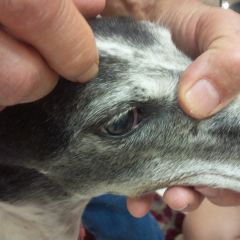
Frontal bone, 1 cun dorsal to mid eyebrow arch (at the end of the visible eyebrow)
|
|
|
|
GB-20
Wind Pond |

Large depression behind the skull, caudal to occipitsl protuberance, lateral to the atlanto-occipital joint, 1.5 cun lateral to the midline on either side of the nuchal ligament.
|
External Wind, Internal Wind, cervical stiffness, headache, nose-bleeding, nasal discharge/congestion, epilepsy
|
|
|
GB-21 Shoulder Well |
In the muscle just cranial to the edge of the scapula midway between GV-14 and the acromion.
|
|
|
|
GB-24 Sun and Moon |
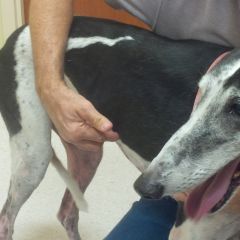
In the 9th intercostal space at the level of the costochondral junction
|
|
|
|
GB-25 Capital Gate |
On the lateral side of the abdomen on the lower border of the free end of the 13th rib. * BL-52 (3 cun lateral to midline, L2) and Bl-23 (1.5cun from midline, L2) are on a straight line going to L2-3 from the last rib |
|
|
|
GB-29
Squatting Bone-hole |
In a depression just cranial to the greater trochanter * one of the 3 bowling ball points around the head of the femur (GB29, BL-54, GB-30) |
Gluteal muscle soreness, pelvic limb pain, arthritis of coxofemoral joint, paralysis of pelvic pain
|
|
|
GB-30
Circular Jump |
In a depression midway between the great trochanter and the tuber ischii * one of the 3 bowling-points around the head of the femur (GB-29, bK-54, GB-30) |
Gluteal muscle soreness, palvic limb pain, arthritis of coxofemoral joint, paralysis of pelvic limb
|
|
|
GB-31 Wind Market |
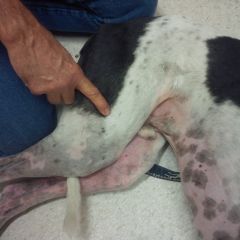
Lateral thigh, in the groove between the femur and the biceps femoris, 7 cun proximal to the lateral femoral condyle. * find lateral condyle of femur, go up along the cranial edge of femur, 7cun up or 11cun from top |
|
|
|
GB-33 Knee Yang Gate |

Between the insertion of the biceps femoris tendon and the femur in a depression proximal to the lateral condyle of the femur. * find lateral condyle like when you check for cranial drawer, this point is right above the condyle |
|
|
|
GB-34
Yang Tomb Spring |
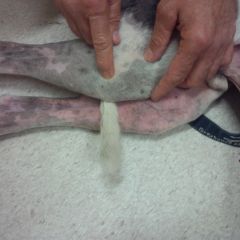
In the depression, just distal and cranial to the head of the fibula on the lateral aspect of the pelvic limb. * grab the knee like checking from cranial drawer, find fibular head with lower hand and go in front of it and a little lower * it is lower than ST-35 a/b * photo shows GB-34 and GB-33 |
He-sea point (Earth), Influential point for ligaments/tendons
Vomiting, biliary disorders, pelvic limb weakness, weakness of ligaments/tendons |
|
|
GB-39
Hanging Bell |
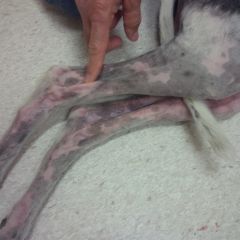
3 cun proximal to the tip of the lateral malleolus in a depression on the caudal border of the fibula near where the lateral saphenous vein crosses. (Opposite SP-6).
|
Influential point for Marrow/CNS.
Cervical stiffness, paresis or paralysis of the pelvic limbs, anal problems, chest pain, sore throat |
|
|
GB-41 Tears on the Foot |
On the dorsum of the pelvic limb paw just distal to the junction of the the 4th and 5th metatarsals * on a line with LIV-3 located between the 2nd and 3rd metatarsals * run your nail as high as you can |
|
|
|
CV-1 Yin meeting |
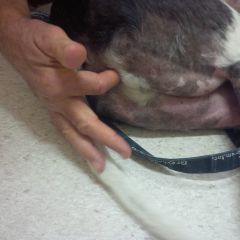
In the depression on the midline halfway betweenthe anus and scrotum or vulva
|
|
|
|
CV-3 Central Pole |
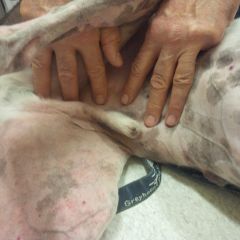
On the ventral midline, 4 cun caudal to the umbilicus. * 6 finger position: pubis = CV-2, then CV-3, CV-4, CV-5, CV-7, CV-8 (umbillicus), 1cun btw each. CV-6 is 1/2 cun btw CV-5 and CV-7 |
|
|
|
CV-4
Origin Pass |
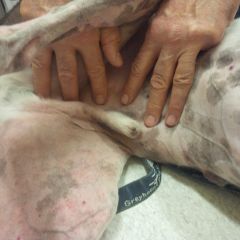
On the ventral midline, 3 cun caudal to the umbilicus. * 6 finger position: pubis = CV-2, then CV-3, CV-4, CV-5, CV-7, CV-8 (umbillicus), 1cun btw each. CV-6 is 1/2 cun btw CV-5 and CV-7 |
Front-mu (Alerm) point for Small Intestine. Kidney Qi or Yang tonic, renal failure, impotence, hernia, colic, diarrhea, loss of body weight
|
|
|
CV-5 Stone Gate |
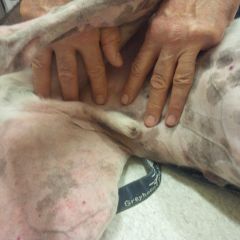
On the ventral midline, 2 cun caudal to theumbilicus. * 6 finger position: pubis = CV-2, then CV-3, CV-4, CV-5, CV-7, CV-8 (umbillicus), 1cun btw each. CV-6 is 1/2 cun btw CV-5 and CV-7 |
|
|
|
CV-6
Sea of Qi |
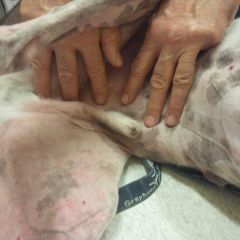
On the ventral midline, 1.5 cun caudal to the umbilicus. * 6 finger position: pubis = CV-2, then CV-3, CV-4, CV-5, CV-7, CV-8 (umbillicus), 1cun btw each. CV-6 is 1/2 cun btw CV-5 and CV-7 |
Kidney Qi or Yang tonic, reanl failure, impotence, hernia, colic, diarrhea, loss of body weight
|
|
|
CV-8 |
umbilicus - moxa only!
|
|
|
|
CV-12 Middle Stomach |
On the ventral midline, halfway between the umbilicus and the xiphoid process.
|
|
|
|
CV-14 Great Palace |
On the ventral midline halfway between CV-12 and the xiphoid process (3/4 the distance from the umbilicus towards the xiphoid process).
|
|
|
|
CV-17 Chest Center |
On the ventral midline in a depression at the level of the 4th intercostal space (ribs 4-5) * between the front legs, feel depression, hard to count ribs |
|
|
|
CV-22 Celestial Chimney |
On the ventral midline at the tip of the manubrium.
|
|
|
|
CV-23 Ridge Spring |
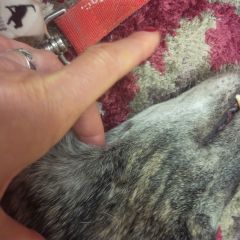
Just cranial to the larynx, on the ventral midline
|
|
|
|
CV-24 Receiving Saliva |
Lower lip on the midline, 1 cun ventral to the rim of the lower lip (chin)
|
|
|
|
GV-1
Long Strong |
Midline halfway between the anus and base of the tail.
|
Luo-connecting point for CV.
Diarrhea, constipation, perianal problems, epilepsy |
|
|
GV-1B Wei-jian |
At the tip of the tail
GV-1 B |
Paralysis of the tail, pelvic limb weakness
|
|
|
GV-3 Yang pass |
Variable location; It is the largest depression located between the dorsal processes of L4-L5, L5-L6 or L6-L7 * find Bai-hui (L7-S1) and go cranial to find deepest depression |
|
|
|
GV-4 Life Gate |
Midline, between the dorsal spinous processes of L2-L3 * find rib 13, trace it up to T13, count L1, L2, L3 * draw a line up from the edge of rib 13 to land at L2-L3 |
|
|
|
GV-6 Center spine |
T11-T12 dorsal midline
|
|
|
|
GV-14
Big Vertebra |
In the depression on the dorsal midline between the C7-T1 dorsal spinous process. * 3-finger technique: thumb and middle finger go on end of scapula, index finger up on the neck as high as you can, then slide down to find the biggest divot = GV-14. Finger should not move when you lift the head up |
High fever, cough, asthma, false Heat, cervical stiffness, hives, epilepsy
|
|
|
GV-17 Tian Men Gate of Heaven |
Midline, on a line drawn from the caudal (trailing) edge of the ears, just proximal to the occipital protuberance
|
|
|
|
GV-20
Hundred Meetings |
In the depression on the dorsal midline on a line drawn from the tips of the ears level with the center of the ear canals.
|
Calming point, Shen disturbance, headache, epilepsy, prolapse of anus
|
|
|
GV-21 Da-feng-men |
Midline, line drawn from cranial rim of ear bases
|
Calm mind, internal wind, seizures, tremors, headache, vertigo, nasal congestion
|
|
|
GV-26 Human Center |
In the philtrum (the vertical line on the upper lipand between the nostrils) at the level of the ventral limits of the nostrils in the non-haired skin.
|
|
|
|
Nao-shu
Brain association point |

Over the temporalis muscle 1/3 of the way along the line between the cranial ear base to the lateral canthus of the eye. * above the zygomatic arch, stay high in the muscle |
Seizures and Shen disturbances
|
|
|
Long-hui Meeting of dragons |
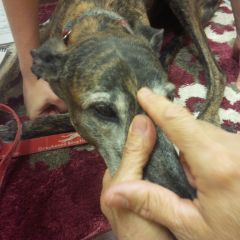
Midpoint between the two temporal fossas at the levelof eyebrows.
|
|
|
|
An-Shen Pacify Shen |
The point is located midway between the dorsal and ventral borders of the ear base in a large depression that is halfway between GB-20 (above) and TH-17 (below)
|
Calm Shen, External Wind, Internal Wind, Stiff neck, headache, nose bleed, nasal congestion, facial paralysis, otitis, deafness
|
|
|
Tai-Yang Great Yang |

1 cun caudal to the lateral canthus above the zygomatic arch * nearby are TH-23 and GB-1 |
|
|
|
Shan-gen
Mountain base |
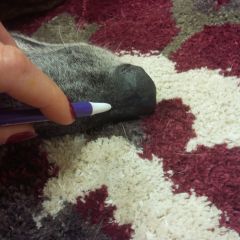
Nose, dosal midline at the junction of hair and non-haired region.
|
Appetite stimulant, shock, coma, Wind-cold, Wind-heat
|
|
|
Jian-wei
Srengthen stomach |
On the lateral cervical region between the jugular vein and the lateral processes of the cervical vertebrae at the junction of the upper and middle 1/3 of the jugular groove. * put thumb in jugular furrow, middle finger goes lateral around the muscle - that's the point, 1/3 down on the neck |
Appetite stimulant, vomiting, stomach disorders
|
|
|
Bi-tong
Nose Passing |
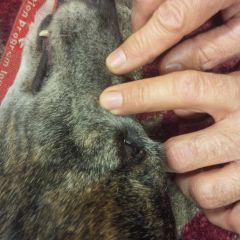
Midpoint between LI-20 and BL-1 * a little lateral from midline |
Nasal congestion, sinusitis, facial paralysis
|
|
|
Er-jian
Ear tip |
Convex surface of the ear at angular vein at ear tip * top of the ear at tip |
Fever, Wind-Heat, Heat, abdominal pain
|
|
|
Jian-jia-ji
Cervical Hua-tuo-jia-ji |
Above and below the transverse process of the cervical vertebrae (7 above, 7 below) * turn the head away to palpate easier * lateral to the jugular groove, deep, you can count up to C5, then it is hard |
Cervical stiffness and Wobbler's disease
|
|
|
Ding-chuan
Stop cough |
0.5 cun lateral to GV-14
|
Cough, asthma
|
|
|
Tian-ping
Scale |
Between T13-L1 on dorsal midline * follow the 13th rib to T13, then go behind it. |
Stop hemorrhage internally, hematuria, castration/spaying bleeding
|
|
|
Bai-hui
Hundred meetings |
Between L7-S1 on dorsal midline depression * 3 finger technique: thumb and middle finger go on tips of ileum, index goes a little caudal to find large depression that is L7-S1 |
Yang deficiency, diarrhea, constipation, intervertebral disk disease, Pelvic limb paresis or paralysis
|
|
|
Shen-shu
KIdney association point |
1 cun lateral to Bai-hui * BL channel is 1.5 cun lateral to midline |
Source Qi, Kidney Qi, Yang Deficiency, diarrhea, constipation, IVDD, pelvic limb paresis or paralysis
|
|
|
Shen-peng Kidney Shelf |
1 cun cranial to Shen-shu
|
|
|
|
Shen-jiao Kidney corner |
1 cun caudal to Shen-shu
|
|
|
|
Wei-jie Tail Vertebrae |
Between Cd-1 and Cd-2 ondorsal midline
|
|
|
|
Hua-tuo-jia-ji
Hua-tuo's paravertebral points |
0.5 cun lateral to each vertebra T-1 to L-7 (19pts) * inner BL meridian is 1.5cun lateral from midline * T1 is at the cranial edge of scapula, pinch the spinous process |
Intervertebral disk disease, back pain
|
|
|
Er-yan
Two eyes Sacral foramina |
In the pelvic sacral foramina 2 pairs of bilateral points * find Bai-hui (L7-S1), then S1-S2 and S2-S3, lateral to Shen-shu, on medial edge of ileum (?) |
Lambosacral pain, pelvic limb paresis, infertility, metritis
|
|
|
Fei-men Lung gate |
1/3 of the way along the cranial border of scapulafrom dorsal to ventral
|
|
|
|
Fei-pan Lung hugging |
1/3 of the way along the caudal border of the scapula from dorsal to ventral
|
|
|
|
Zhou-shu Elbow association point |
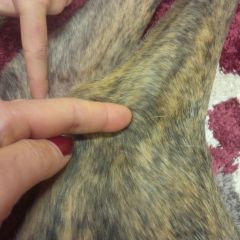
Between the lateral humeral condyle and the anconeal process (Opposite SI-8 on medial side) * hug the condyle |
|
|
|
Jian-jiao Coxa angle |
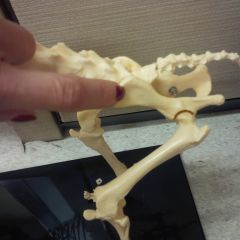
In the depression just ventral to the dorsaol border of the wing of the ilium * find the tip of Ileum, feel the curve caudal and fall downwards (over it), in fossa |
|
|
|
Liu-feng
Six raphes |
Between the digits in skin folds- 3 points on each foot (6 points rear limbs, 6 points thoracic limbs). Insert needle through webbing and dorsal to the metacarpophalangeal or metatarsophalangeal joints.
|
Paresis, paralysis
|

